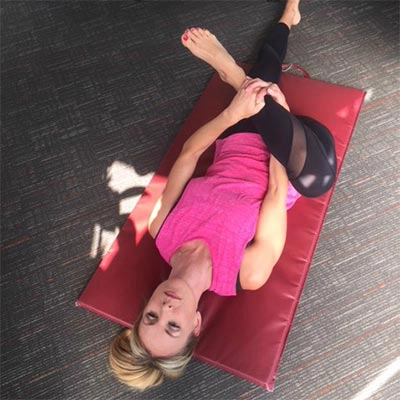Stretching will not only help increase your overall flexibility but will also help improve your posture, manage pain caused by tight muscles and help you stay balanced. Since muscles come in pairs that ideally counterbalance each other, stretching and strengthening the muscles opposite the ones that always seem tight will be of benefit. Contact our Calgary AB chiropractic clinic to experience an improvement in health.
Stretching Exercises IN Calgary AB
Stretching tight muscles can also help counteract the negative effects of sitting for long periods of time. Hunching over a desk all day can create muscle tightness that can lead to poor posture and pain. Stretching will help correct habitual posture problems, which can translate to reduced lower back pain. One of the best reasons to stretch is to help prevent injuries.
Below is a prescribed series of stretches designed to improve flexibility and postural performance.
Supine Piriformus Stretch
Stretching the piriformis muscle is almost always necessary to relieve the pain related to sciatica. Lying on your back, place your hand on the same side of one knee, with the other hand on the raised heel. Gently raise the knee toward your shoulder and cross the calf across your body toward the opposite shoulder.


Hip Flexor Stretch
This is a great stretch for those that sit for extended periods of time. These muscles get short, and tight, and can pull the pelvis out of alignment if they are not stretched properly. Starting in the half kneeling position move your hips and trunk forward until a stretch is obtained in the hip pocket (hip flexors) of the thigh whose knee is kneeling on the ground. Take care not to arch the back.
Hold 1 Minute Per Side - Once or Twice per Day
Pigeon Pose
This poses perfect for tight hips. Many people are familiar with tight hips. Activities and sports that include running and jumping can make the outer hips tight, and sitting for long periods of time can shorten and stiffen the front hip flexors. This is a powerful hip opener that can help increase flexibility and the range of motion in the hip joints.

How to Pigeon Pose:
- Start on all fours in a squared table pose.
- Slide the right knee forward toward your right hand. Angle your right knee at two o'clock.
- Slide your left leg back as far as your hips will allow.
- Keep your hips square to the floor. If your hips are not square, there will be unnecessary force on your back, and you won't be able to open the hips to their fullest.
- If you're not feeling a deep stretch in your right glute, slide the right foot forward--little by little--toward your left hand. With practice, bring your foot parallel with the front edge of your mat
- Your right thigh should have an external rotation, and your left thigh should have a slight internal rotation. This keeps pressure off the knee cap.
- Depending on how you feel, you will be upright on your hands while sinking the hips forward and down. Level two will rest on their forearms, and level three will rest the chest on the floor with the arms fully extended in front of you.
- To get full release in the hips, breathe and release the belly. Stay in this position anywhere from 10 breaths to five minutes.

